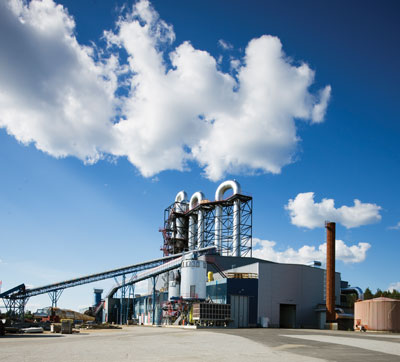
Heat, Power & Pellets
October 31, 2011
By Treena Hein
Combining heat, power, and pellet production all in one facility is a highly efficient use of biomass.
Combining heat, power, and pellet production all in one facility is a highly efficient use of biomass. Europe boasts several combined heat, power, and pellets (CHPP) facilities, and they could make sense in Canada, but only if a few factors such as higher electricity rates are in play.
 |
|
| GreenExergy’s Storuman plant has a 32-MW boiler, 8-MW steam turbine, and produces 16 tons/hour of pellets. Photo: GreenExergy |
“Combining a CHP system with a pellet mill can be an excellent fit,” says Christiane Egger, manager at the Oekoenergie-
Cluster, a network of green energy businesses in Upper Austria. “It can use the waste heat from the CHP to dry the material and for other processing heat demands, and for the electricity demand of the production process,” she observes. “Also, depending on the biomass resource available, the CHP plant can be supplied with less-valuable fractions of the biomass material.” The economics are workable, Egger says, with a suitable feed-in tariff rate in place, but the size of the pellet mill and CHP unit also matter, as does “the possibility of selling additional heat to another heat user nearby.”
The Canadian District Energy Association (CDEA) has been invited to visit district heating systems in Finland and Denmark and is assessing interest among its members in touring these countries in spring 2012. One of the stops may be the Vapo Oy Ilomantsi CHPP plant in Finland, which runs on a combination of peat and wood residues. It has a 20-MW fluidized bed boiler, producing 3.5 MW of electricity, 8 MW of heat to municipal district heating in Ilomantsi, and 8 MW of process heat for its 70,000 tonne/year pellet plant. CDEA president Mary Ellen Richardson notes that the association understands the benefits of visiting plants abroad, given that two of the most recently built Canadian district energy systems had their “inspirational roots” in international study tours.
GreenExergy in Sweden seems to have originated the CHPP concept, having designed and commissioned plants in Hedensbyn in 1996 and Storuman in 2008. These facilities use peat as well as wood residues from forestry operations and sawmills. GreenExergy says that adding pellet production to CHP results in greater efficiencies of energy use, even with wet biomass. Estimated efficiencies for using biomass are 35% for electricity production alone, 88% for CHP, and up to 98% for CHPP.
Gordon Murray, executive director of the Wood Pellet Association of Canada, agrees that CHPP systems do result in high fuel efficiency, “sometimes as high as 95%.” However, he says, “the downside is that at a small scale it has not yet proven economic.”
The CHP plant at the CHPP in Hedensbyn was built for wet biofuels and has two fluidized bed boilers. Its pellet plant has an additional steam turbine that recycles and uses the energy that goes through the drying process, providing an additional 25–30 GWh/year of power. In fact, both of GreenExergy’s CHPP plants boast a pressurized steam circuit with feedstock drying and a steam turbine. The company says the process is based on innovative technology for drying raw materials, technology which considerably improves the energy efficiency of the production compared to alternatives.
“At the heart of the process is the so-called SSD dryer (superheated steam dryer),” says Rolf Lindgren, GreenExergy vice-president. “This dryer operates in an enclosed environment at 170°C and 4 bar pressure. The wet fuel, let’s say wood with 50% moisture, is injected into the closed loop of the dryer. It will dry in about 20 to 30 seconds and is then taken out of the loop through cyclones. The water that came in with the wet wood creates, at the same time, a ‘dirty steam’ at the operating pressure.” This steam is taken out of the dryer and to a heat exchanger to produce clean steam by condensing out the impurities. The clean steam is then used in a turbine to produce electricity.
“All in all, we only need 140 kWh/ton of evaporated water for drying compared to conventional drying systems (rotary and belt dryers) that take 10 times more energy,” notes Lindgren. “In a so-called bioenergy combine, we have three outgoing products: electricity, district heating, and wood pellets.” He says the proportions of end product among these three can change depending on the profitability of each, with the entire system being most profitable when fuel prices are high.
Murray agrees. “Fossil fuel prices are much higher in Europe than here, and there is also much stronger policy support there to cut greenhouse gases and use renewable fuels,” he says. “This means that CHP systems, let alone CHPP systems, have to compete with fossil fuels here in Canada on price alone.” Murray observes that CHP has really only so far been financially feasible at pulp and paper mills, which are intensive power users. “Sawmills have added biomass heat for kiln drying, but adding power generation takes more investment,” he says. “Current rates the utilities are willing to pay will not allow sawmills to generate sufficient return on capital to justify the investment. Alternatively, CHP would be good to add at a pellet plant if there could be sufficient return for capital.” Murray notes that presently, pellet producers use biomass boilers to create heat for the drying process, but not electricity.
“At [current rates], there is insufficient profitability to incent pellet producers to add electrical generating capacity,” Murray says. “Until there is more pressure and a stronger political will to support renewable energy systems in Canada, we will not see CHPP move forward here. But they are a great example of what could be achieved with full use of Canadian biomass.”
Print this page